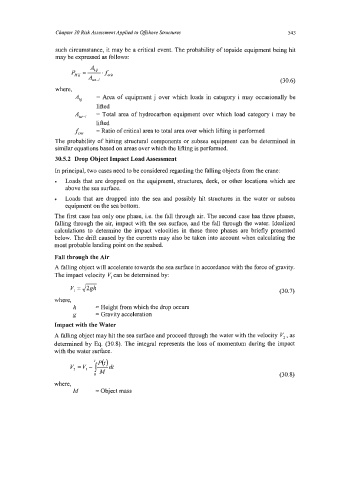Page 567 - Marine Structural Design
P. 567
Chapter 30 Risk Assessment Applied to off ore Structures 543
such circumstance, it may be a critical event. The probability of topside equipment being hit
may be expressed as follows:
(30.6)
where,
A,# = Area of equipment j over which loads in category i may occasionally be
lifted
Afof-j = Total area of hydrocarbon equipment over which load category i may be
lifted
f,, = Ratio of critical area to total area over which lifting is performed
The probability of hitting structural components or subsea equipment can be determined in
similar equations based on areas over which the lifting is performed.
30.5.2 Drop Object Impact Load Assessment
In principal, two cases need to be considered regarding the falling objects from the crane:
Loads that are dropped on the equipment, structures, deck, or other locations which are
above the sea surface.
Loads that are dropped into the sea and possibly hit structures in the water or subsea
equipment on the sea bottom.
The first case has only one phase, i.e. the fall through air. The second case has three phases,
falling through the air, impact with the sea surface, and the fall through the water. Idealized
calculations to determine the impact velocities in these three phases are briefly presented
below. The drift caused by the currents may also be taken into account when calculating the
most probable landing point on the seabed.
Fall through the Air
A falling object will accelerate towards the sea surface in accordance with the force of gravity.
The impact velocity can be determined by:
v, =J27qk (30.7)
where,
h = Height from which the drop occurs
g = Gravity acceleration
Impact with the Water
A falling object may hit the sea surface and proceed through the water with the velocity Vz , as
determined by Eq. (30.8). The integral represents the loss of momentum during the impact
with the water surface.
(30.8)
where,
M = Object mass

